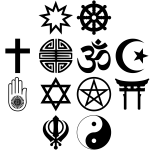Introduction
The human spirit seems to search for meaning in a whole variety of ways. Some people use science to help them search. Some practice physical disciplines. Some find a leader to follow. Some study various philosophies. And many use some variety of religious tradition or spiritual expression to order their search, to name their lives’ meaning, to structure their lives’ activities.
This text is a compilation of materials that talk about just a few of the many ways that more recent human groups have created religion and religious practice. There are indications that truly ancient groups of people also had religious traditions, but we are going to start, in this text, with materials found within the last 4,000 years or so. Religions continue to evolve, of course, but these given traditions in the text will have some basic information about their histories, their belief, and their structure, that can help the student of religion understand them– at least at a basic level.
The text is set up, in part, geographically. Religious traditions all begin somewhere, and it is the places of origin that set a tone and feel for each of those traditions. There will be chapters indicating specific faiths, and with each geographic section containing, as well, a whole set of links to interesting outside resources, many that could provide additional activities, information, or assignments.
There will be traditions that are not included here. Truthfully, the study of humans and religion, spiritual quests and faith is enormous. One could not possibly cover it all. But knowing something about various large and global traditions is essential in our increasingly mobile and interactive world.
(Because this text uses materials that are Creative Commons Licensed, there is mixing of materials from various sources together with my own writing. Errors are completely mine, and I will certainly look to fix anything found here. The sources for each chapter are found at the end of the chapter. Creative Commons licensing allows for serious editing, and you may find it a little unusual compared to the normal academic writing. OER textbooks will frequently be an interesting mashup of various sources, resources, voices and ideas. The unifying link in all of this material is that the editing author chooses what to include, and how to format it. The major voices in each chapter include that of the editing author, but also those academics who have made their materials Creative Commons licensed for use, re-use and attribution. Their contributions will be in the bibliography for each chapter of the book, and sometimes in footnoted sections, as well. Parts of each chapter are written by these outsides scholars, and parts by the author of this text. These are frequently woven together in any one paragraph or page! Understanding how this composition process works is helpful when considering using an OER textbook as a teacher or a student.)
Jody Ondich
Duluth, MN
October 2021


